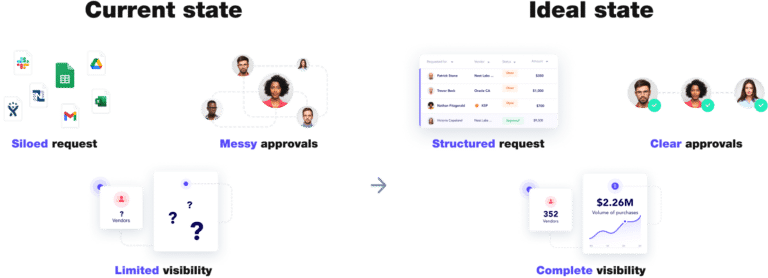Designing a Modern Purchasing Process
As organizations grow, procurement and finance responsibilities naturally become more complex. From a relatively small number of vendors and purchases to manage, procurement and finance managers find themselves overseeing purchasing and partnership activities addressing a variety of business needs for a number of departments and teams.
When purchasing operations become so complex that bottlenecks and frustration begin to characterize them, businesses awaken to the urgent need for transforming and modernizing the way they handle requisitions. The goal: Making purchasing easier and faster for buyers, and giving approvers more control and involvement in the purchasing process.
Here’s a glimpse of how an outdated, inefficient and cumbersome purchasing looks vs a more efficient operation:

The ideal purchasing process for a fast-growing company needs to be seamless for requesters and approvers, and connected to your organization’s ERP and other systems.
The Steps of a Modern Purchasing Process

Purchasing process diagram
When broken down into steps, the ideal requisition process looks something like this:
- First, a requester in need of a product or a service submits a purchase request. The purchase request is a simple form containing all the information needed to trigger the right approval process.
Note that letting employees submit requests—even if they don’t know which vendor they should work with—is a great way for finance and procurement teams to get involved on time and break the siloed communication happening on emails and Slack messages (capturing the entire process and all related data).
Another important part of this first step, the requester can also request to onboard a new vendor if the one they want to work with isn’t already registered with the company. The central value here is that onboarding a new vendor is triggered during the request stage, and is, therefore, faster and better tracked.
- Once the purchase request is submitted, approvers are notified via email and can then log into a system where they can see all the relevant information needed to approve the request. In this system, they can easily check up-to-date budget statuses and make sure the need and the terms are good-to-go on their end. If they’re uncertain about whether or not to approve the request, they can return the request to the requester in order to ask a question, or consult with another stakeholder (often another one of the approvers). Approvers need to be accountable, so the system should remind them when they’re taking too long to address an open item.
- Once approved, a PO based on the purchase request should be generated. The PO should live in the company’s ERP. Generating a PO in your ERP has two main benefits. First, it saves a ton of manual work for the AP team, since flipping the PO into an invoice/bill is much simpler than typing all of the purchase request information into the system manually. Second, it makes your budget planning that much better, since you can plan in advance before an invoice is received.
- The next step is for the requester (or the person for whom the request was opened) to ensure they received the goods or services they asked for. This step is important because it ensures that you only pay for what you received. It’s needless to say that in fast-moving organizations, a lot of spend can “disappear” this way.
The requester should be notified on the expected arrival date and mark receival, either full or partial, and this should in turn be transmitted to the PO’s line item in the ERP. This allows the AP team to achieve a 3-way match without needing to manually forward the invoice to the requester (who might merely look at a financial file they don’t know how to read).
- An additional step in the modern purchasing process involves monitoring and improving. This is done by measuring and optimizing for the parameters that are most important to the organization. The time it takes from submitting a purchase request to issuing the PO is a good metric for process efficiency. The number of ‘actions’ or steps needed in an approval process (edits, vendor changes, questions) is a good metric for process quality.
Once your modern purchasing process is in full motion, you’ll see huge benefits across every part of your organization. Beyond accelerated operations, you and your team will have achieved much-needed visibility into every stage of every procurement and purchasing process. The finance team will gain the ability to create an accurate budget forecast at any time, giving your company a strong handle over its spending activities. Budget owners across departments will be able to access real-time budget information that enables them to make smarter, more informed decisions. And spend becomes properly controlled. Congratulations!